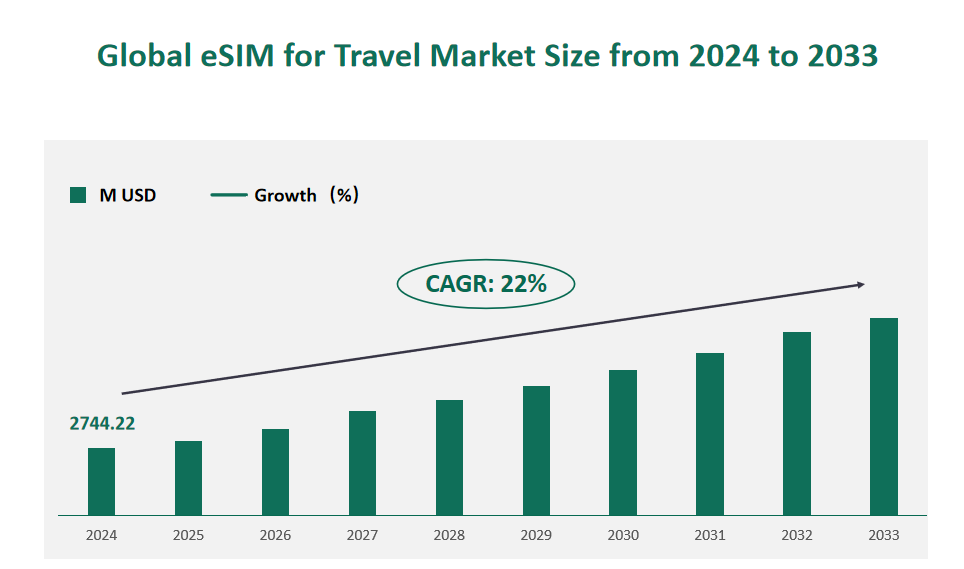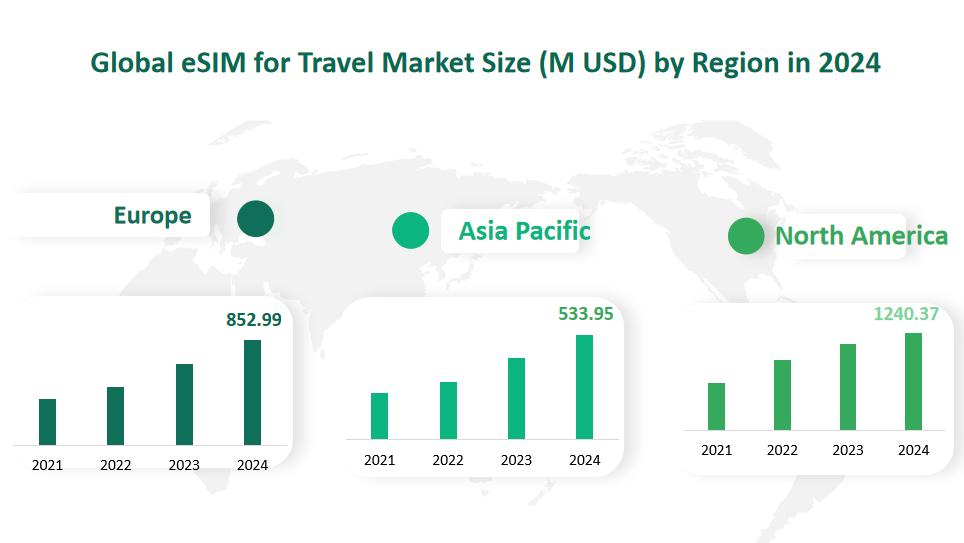1 Global eSIM for Travel Market Size (Value) and CAGR (2024-2033)
The eSIM for Travel market is projected to experience significant growth in the coming years, with the total global eSIM for Travel value reaching $2744.22 million in 2024, growing at a CAGR of 22% from 2024 to 2033.
An eSIM is an embedded SIM card that connects to a mobile network without the need for a physical SIM card. They’ve grown in popularity as people look for more convenient ways to stay connected while traveling. The combination of eSIM and international travel means no exorbitant fees or terribly slow service when users use their phones overseas.
Figure Global eSIM for Travel Market Size (M USD) and CAGR 2024-2033

2 Drivers and Challenges of the eSIM for Travel Market
The eSIM for Travel market is experiencing a transformative phase, with several driving factors expected to fuel its growth and some challenges that could hinder its progress.
Driving Factors:
One of the primary drivers of the eSIM for Travel market is the increasing demand for seamless connectivity among travelers. As international travel becomes more frequent, the need for reliable and cost-effective data services while abroad has surged. eSIM technology addresses this need by offering a digital solution that eliminates the hassle of physical SIM swaps and expensive roaming charges. The growing adoption of IoT devices in various industries, particularly in travel and hospitality, further bolsters the market’s expansion, as eSIM facilitates easier management and connectivity of these devices.
Another significant driver is the advancements in 5G technology, which promises enhanced network capabilities. eSIM is well-positioned to leverage these advancements, providing a flexible solution for 5G-enabled devices. The technology’s ability to support multiple profiles and switch between networks dynamically gives it a competitive edge, making it an attractive option for both business and leisure travelers.
The integration of eSIM into a wide range of devices, including smartphones, tablets, and smartwatches, is also a key factor. This integration not only enhances user experience but also opens up new market segments, contributing to the overall growth of the eSIM for Travel market.
Factors Challenging the Market:
One of the main challenges is the interoperability and standardization issues among different operators and devices. The lack of a unified standard can lead to compatibility problems, limiting the technology’s potential reach and effectiveness.
Regulatory hurdles represent another challenge, particularly in regions where eSIM technology is still in its infancy. Policymakers in some countries have yet to establish a clear regulatory framework for eSIM, creating uncertainty for both service providers and consumers.
Additionally, the market faces competition from traditional SIM card providers, who may be reluctant to adopt eSIM due to the potential disruption to their existing business models. This resistance can slow down the adoption rate of eSIM technology in the travel sector.
3 Technology Status and Developments in the eSIM for Travel Market
The eSIM for Travel market is currently at the epicenter of a technological shift, with the embedded SIM technology revolutionizing mobile connectivity for travelers. eSIM, or embedded SIM, represents a significant leap forward from traditional SIM cards, offering a digital and remotely configurable solution that is integrated directly into devices. This technology status signifies a move towards more flexible, secure, and convenient means of managing mobile connections, particularly for those who travel frequently.
One of the key developments in the eSIM for Travel market is the enhancement of remote SIM provisioning. This capability allows users to activate and switch mobile plans without the need for a physical SIM card, providing flexibility to access various networks across different regions. This feature is especially beneficial for international travelers who require reliable and cost-effective connectivity without the hassle of swapping SIM cards or incurring high roaming charges.
The technology is also evolving to support an increasing number of devices, with a growing number of smartphones, tablets, and wearables now being manufactured with eSIM compatibility. This expansion is a critical development, as it broadens the reach of eSIM technology and increases its adoption among consumers and businesses alike.
Another significant technological advancement is the integration of eSIM with emerging technologies such as 5G and the Internet of Things (IoT). The combination of eSIM with 5G promises faster data speeds and improved connectivity, which is essential for a seamless travel experience in today’s digital world. In the context of IoT, eSIM enables the remote management of connected devices, which is particularly useful for tracking and managing assets in transit across international borders.
4 Global eSIM for Travel Market Size by Type in 2024
The global eSIM for Travel market, as projected for the year 2024, is anticipated to demonstrate significant growth, with distinct types of eSIM services contributing to this expansion.
Data Only eSIM for Travel:
The Data Only segment refers to eSIM services that provide internet connectivity without voice or SMS capabilities. This type is particularly popular among travelers who require high-speed data access for activities such as online browsing, streaming, and social media updates while abroad. In 2024, the Data Only eSIM for Travel market is forecasted to generate a revenue of $2,232.17 million. This segment is favored for its simplicity and cost-effectiveness, especially in regions with widespread Wi-Fi usage for voice and messaging services.
Voice, SMS, and Data eSIM for Travel:
Contrasting the Data Only segment, the Voice, SMS, and Data type encompasses comprehensive communication services, including voice calls, SMS messaging, and data connectivity. This full-service option is ideal for travelers who need to stay connected through various means without incurring high roaming fees. The market revenue for this type in 2024 is projected to be $512.05 million. The appeal of this segment lies in its versatility, offering a one-stop solution for all communication needs while traveling.
Table Global eSIM for Travel Market Size by Type in 2024
Type | Market Size (M USD) 2024 |
Data Only | 2232.17 |
Voice, SMS, and Data | 512.05 |
Total | 2744.22 |
5 Global eSIM for Travel Market Size by Application in 2024
The global eSIM for Travel market, when segmented by application, reveals a nuanced landscape where two primary sectors drive the industry: B2B (Business-to-Business) and B2C (Business-to-Consumer).
B2B Application:
The B2B segment of the eSIM for Travel market is tailored towards business clients, offering customized solutions that cater to the specific needs of enterprises. This could include solutions for international communication, data management, and device connectivity for business travelers. The market revenue for the B2B application is projected to be $480.87 million in 2024. This segment is expected to grow as companies increasingly recognize the value of streamlined connectivity in a global business environment.
B2C Application:
On the other hand, the B2C segment targets individual consumers, providing eSIM services for personal use during international travel. This segment is anticipated to capture a larger share of the market, with a projected revenue of $2,263.35 million in 2024. The appeal of the B2C application lies in its convenience for travelers who seek to avoid roaming charges and the inconvenience of changing SIM cards while abroad.
Table Global eSIM for Travel Market Size by Application in 2024
Application | Market Size (M USD) 2024 |
B2B | 480.87 |
B2C | 2263.35 |
Total | 2744.22 |
6 Global eSIM for Travel Market Size by Region in 2024
The global eSIM for Travel market, when examined through a regional lens, presents a dynamic picture of varying market sizes and growth potentials.
North America is anticipated to be a major contributor to the global eSIM for Travel market, with a projected revenue of $1,240.37 million in 2024. The region’s mature telecom infrastructure and high adoption rate of new technologies position it as a leader in the eSIM market.
Europe follows closely, with a market revenue projection of $852.99 million for 2024. The region’s strong regulatory support for digital innovation and widespread travel industry make it a key player in the eSIM for Travel market.
The Asia Pacific region is expected to show robust growth, with a projected revenue of $533.95 million in 2024. The region’s large population, increasing disposable income, and growing tourism industry are driving factors for the eSIM market’s expansion.
Latin America and the Middle East & Africa are also projected to contribute to the market, with revenues of $74.63 million and $42.27 million respectively in 2024. These regions, despite starting from a smaller base, are expected to experience growth due to increasing digital penetration and a rising demand for mobile connectivity solutions.
Figure Global eSIM for Travel Market Size by Region in 2024

7 Major Players in Global eSIM for Travel Market
7.1 Verizon
Verizon, established in 2000, is a leading global provider of technology and communications services. Headquartered in New York City, the company operates worldwide, delivering voice, data, and video services across its award-winning network. As the first company to launch commercial 5G for mobile and fixed wireless services, Verizon has been at the forefront of innovation.
In 2023, Verizon reported revenues of $362.28 million and a gross margin of 42.65%.
7.2 AT&T
AT&T, founded in 1983, is a telecommunications giant with a global presence. The company operates through its Communications and Latin America segments, serving businesses and consumers in the U.S. and global corporations. AT&T has been a key player in the evolution of telecommunications, offering a range of services from entertainment to wireless services outside the United States.
AT&T’s eSIM offerings include digital SIM cards that provide flexibility in managing wireless plans and are used in some of the latest devices from manufacturers like Samsung.
In 2023, AT&T’s revenue reached $271.72 million, with a gross margin of 39.98%.
7.3 Telekom
Telekom, established in 1995, is a worldwide integrated telecommunications company with a significant mobile subscriber base and a strong presence in fixed-network lines and broadband services. The company operates in over 50 countries, providing a wide array of ICT solutions to business and enterprise customers.
Telekom’s eSIM products and services include embedded SIM cards that are permanently installed in mobile devices, replacing the traditional plastic SIM card and offering a more convenient and environmentally friendly solution.
Telekom’s 2023 financials reflect a revenue of $207.60 million and a gross margin of 40.65%.

